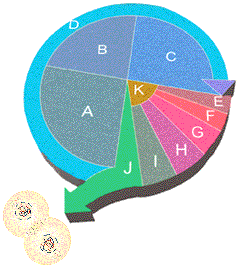
In this lesson you will learn how cells divide to form daughter cells that contain the same chromosome complement and genes as the mother cell. The cell cycle includes both the replication and separation of the nuclear material (mitosis or karyokinesis) and the separation of the cytoplasm into two cells each of which retain one of the nuclei.

The figure above represents a cycle that Eukaryote cells pass through during cell division. It is broken down into five parts A=(G-1), C=(G-2), B=(S) K=(M) J=(Cytokinesis). "D" represents a stage called interphase which includes G-1,S, G-2. Each single cell (mother cell) that enters this cycle will form two cells (daughter cells). Note - the two daughter cells formed will contain the same number of chromosomes as the mother cell. Read the pages indicated by G-5 and study behavioral objective 7. Draw in this cycle in your notes and write a paragraph describing the what occurs during each part of the cell cycle. These descriptions can be found in the text in the readings indicated by G-5. Include the following: G1, G2, S, Mitotic, cytokinesis. The mitotic stage will be divided into five phases (E,F,G,H,I) which will be discussed later.
1. Examine the eukaryotic cell cycle. List the correct order of events.
- a) G-1, G-2, S, M, cytokinesis
- b) S, G-1, G-2, M, cytokinesis
- c) G-1, S, G-2, cytokinesis, M
- d) G-1, S, G-2, M, cytokinesis
- Press here to check answer. press
2. Match the following descriptions listed below to the following parts of the life cycle.
A = G-1, B = S, C = G-2, K = mitosis, J = cytokinesis, D = interphase
1. DNA replication occurs
2. Normal cell activities - acquires nutrients from
environment, growth, etc.
3. Chromosomes segregate into two locations within
the cell
4. Cytoplasm divides into two parts forming two
cells
5. Cell synthesizes molecules to prepare for mitosis
1
2
3
4
5
____________________________________________
a. A
B
J
K
D
b. B
J
A
D
K
c. B
A
K
J
C
d. C
J
K
A
B
Press here to check your answer.
Click here for more questions.
For information on how to use this page, go to How
to Use This Site.
Created by the Center for Learning Technologies, Academic Technology Services.
Last modified October 22, 1997.